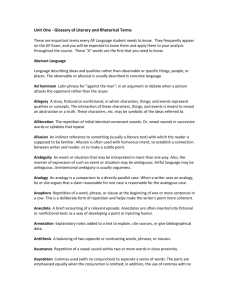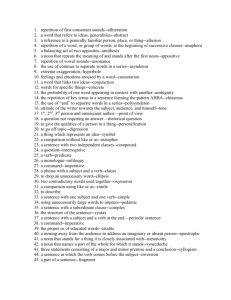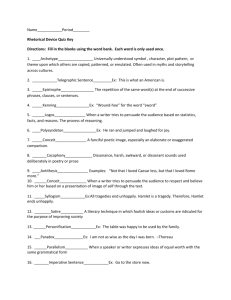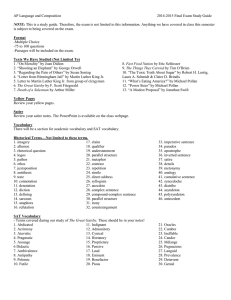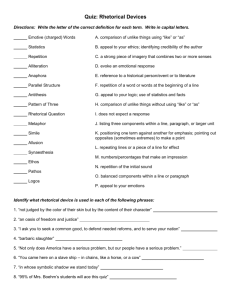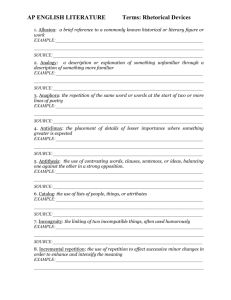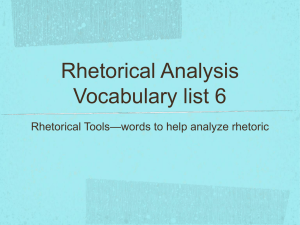AP English 3 Vocab List #1 Ad Hominem: In an argument, this is an
advertisement
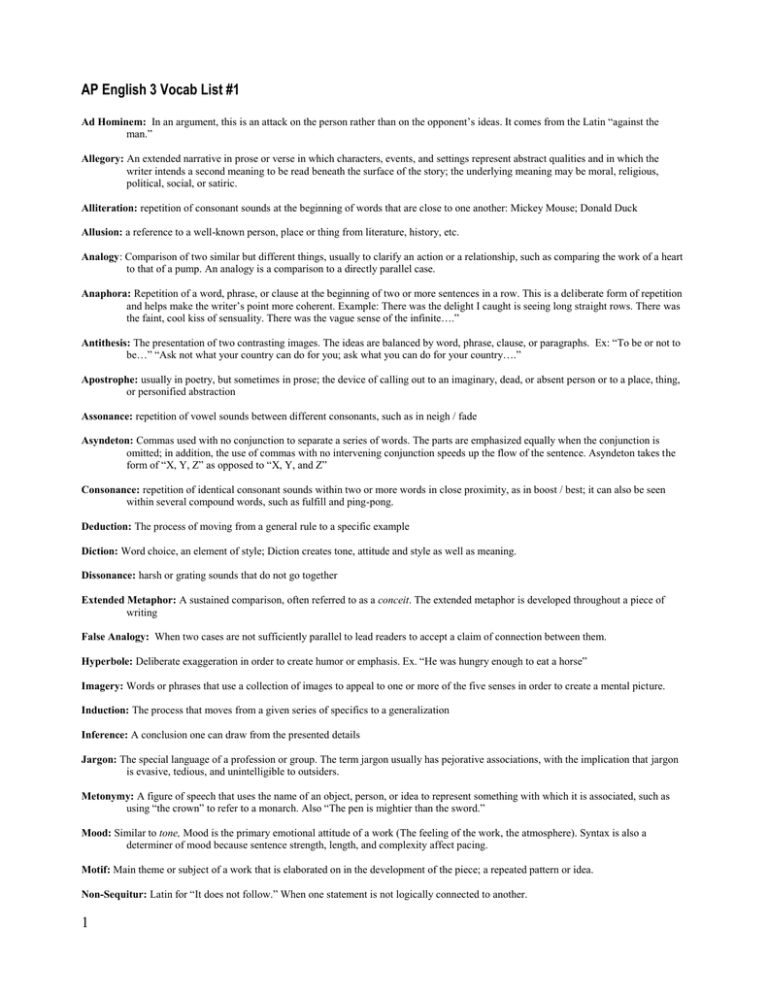
AP English 3 Vocab List #1 Ad Hominem: In an argument, this is an attack on the person rather than on the opponent’s ideas. It comes from the Latin “against the man.” Allegory: An extended narrative in prose or verse in which characters, events, and settings represent abstract qualities and in which the writer intends a second meaning to be read beneath the surface of the story; the underlying meaning may be moral, religious, political, social, or satiric. Alliteration: repetition of consonant sounds at the beginning of words that are close to one another: Mickey Mouse; Donald Duck Allusion: a reference to a well-known person, place or thing from literature, history, etc. Analogy: Comparison of two similar but different things, usually to clarify an action or a relationship, such as comparing the work of a heart to that of a pump. An analogy is a comparison to a directly parallel case. Anaphora: Repetition of a word, phrase, or clause at the beginning of two or more sentences in a row. This is a deliberate form of repetition and helps make the writer’s point more coherent. Example: There was the delight I caught is seeing long straight rows. There was the faint, cool kiss of sensuality. There was the vague sense of the infinite….” Antithesis: The presentation of two contrasting images. The ideas are balanced by word, phrase, clause, or paragraphs. Ex: “To be or not to be…” “Ask not what your country can do for you; ask what you can do for your country….” Apostrophe: usually in poetry, but sometimes in prose; the device of calling out to an imaginary, dead, or absent person or to a place, thing, or personified abstraction Assonance: repetition of vowel sounds between different consonants, such as in neigh / fade Asyndeton: Commas used with no conjunction to separate a series of words. The parts are emphasized equally when the conjunction is omitted; in addition, the use of commas with no intervening conjunction speeds up the flow of the sentence. Asyndeton takes the form of “X, Y, Z” as opposed to “X, Y, and Z” Consonance: repetition of identical consonant sounds within two or more words in close proximity, as in boost / best; it can also be seen within several compound words, such as fulfill and ping-pong. Deduction: The process of moving from a general rule to a specific example Diction: Word choice, an element of style; Diction creates tone, attitude and style as well as meaning. Dissonance: harsh or grating sounds that do not go together Extended Metaphor: A sustained comparison, often referred to as a conceit. The extended metaphor is developed throughout a piece of writing False Analogy: When two cases are not sufficiently parallel to lead readers to accept a claim of connection between them. Hyperbole: Deliberate exaggeration in order to create humor or emphasis. Ex. “He was hungry enough to eat a horse” Imagery: Words or phrases that use a collection of images to appeal to one or more of the five senses in order to create a mental picture. Induction: The process that moves from a given series of specifics to a generalization Inference: A conclusion one can draw from the presented details Jargon: The special language of a profession or group. The term jargon usually has pejorative associations, with the implication that jargon is evasive, tedious, and unintelligible to outsiders. Metonymy: A figure of speech that uses the name of an object, person, or idea to represent something with which it is associated, such as using “the crown” to refer to a monarch. Also “The pen is mightier than the sword.” Mood: Similar to tone, Mood is the primary emotional attitude of a work (The feeling of the work, the atmosphere). Syntax is also a determiner of mood because sentence strength, length, and complexity affect pacing. Motif: Main theme or subject of a work that is elaborated on in the development of the piece; a repeated pattern or idea. Non-Sequitur: Latin for “It does not follow.” When one statement is not logically connected to another. 1 Oversimplification: When a writer obscures or denies the complexity of the issues in an argument. Pacing: The movement of a literary piece from one point or section to another. Parallelism: The technique of arranging words, phrases, clauses, or larger structures by placing them side-by-side and making them similar in form. Parallel structure may be as simple as listing two or three modifiers in a row to describe the same noun or verb; it may take the form of two or more subordinate clauses that modify the same noun or verb. Or, parallel structure may be a complex bend of single-word, phrase and clause parallelism all in the same sentence. Ex: (from Churchill) “We shall fight on the beaches, we shall fight on the landing grounds, we shall fight in the fields.” Parody: A work that ridicules the style of another work by imitating and exaggerating its elements. It can be utterly mocking or gently humorous. It depends on allusion and exaggerates and distorts the style and content. Pedantic: A term used to describe writing that borders on lecturing. It is scholarly and academic and often overly difficult and distant. Polysyndeton: A sentence which uses ‘and’ or another conjunction (with no commas) to separate the items in a series. Polysyndeton appear in the form of “X and Y and Z”, stressing equally each member of a series. It makes the sentence slower and the items more emphatic than in the asyndeton. Red Herring: When a writer raises an irrelevant issue to draw attention away from the real issue. Reductio ad Absurdum: The Latin for “to reduce to the absurd.” This is a technique useful in creating a comic effect and is also an argumentative technique. It is considered a rhetorical fallacy because it reduces an argument to an either/or choice. Repetition: Word or phrase used two or more times in close proximity. Rhetoric: The art of effective communication, especially persuasive discourse. Rhetoric focuses on the interrelationship of invention, arrangement, and style in order to create felicitous and appropriate discourse. Rhetorical Question: A question that does not expect an explicit answer. It is used to pose an idea to be considered by the speaker or audience. Satire: A work that reveals a critical attitude toward some element of human behavior by portraying it in an extreme way. Satire doesn’t simply abuse (as in invective) or get personal (as in sarcasm) Straw Man: When a writer argues against a claim that nobody actually holds or is universally considered weak. Syllogism: A form of reasoning in which two statements are made and a conclusion is drawn from them. A syllogism is the format of a formal argument that consists of a major premise, a minor premise, and a conclusion. Example: Major Premise: All tragedies end unhappily Minor Premise: Hamlet is a tragedy. Conclusion: Therefore, Hamlet ends unhappily Synecdoche: a figure of speech in which a part of something is used to represent a whole, such as using ‘boards’ to mean a stage or ‘wheels’ to mean a car – or “all hands on deck” Syntax: The grammatical structure of a sentence; the arrangement of words in a sentence. Syntax includes length of sentence, kinds of sentences (questions, exclamations, declarative sentences, rhetorical questions, complex or compound) Theme: The central idea or “message” of a literary work. Thesis: The main idea of a piece of writing. It presents the author’s assertion or claim. Tone: The characteristic emotion or attitude of an author toward the characters, subject, and audience (anger, sarcastic, loving, didactic, emotional, etc) Understatement: The opposite of exaggeration. It is a technique for developing irony and/or humor where one writes or says less than intended. 2
